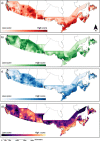Spatial multi-criteria decision analysis for the selection of sentinel regions in tick-borne disease surveillance
- PMID: 38267914
- PMCID: PMC10809750
- DOI: 10.1186/s12889-024-17684-x
Spatial multi-criteria decision analysis for the selection of sentinel regions in tick-borne disease surveillance
Abstract
Background: The implementation of cost-effective surveillance systems is essential for tracking the emerging risk of tick-borne diseases. In Canada, where Lyme disease is a growing public health concern, a national sentinel surveillance network was designed to follow the epidemiological portrait of this tick-borne disease across the country. The surveillance network consists of sentinel regions, with active drag sampling carried out annually in all regions to assess the density of Ixodes spp. ticks and prevalence of various tick-borne pathogens in the tick population. The aim of the present study was to prioritize sentinel regions by integrating different spatial criteria relevant to the surveillance goals.
Methods: We used spatially-explicit multi-criteria decision analyses (MCDA) to map priority areas for surveillance across Canada, and to evaluate different scenarios using sensitivity analyses. Results were shared with stakeholders to support their decision making for the selection of priority areas to survey during active surveillance activities.
Results: Weights attributed to criteria by decision-makers were overall consistent. Sensitivity analyses showed that the population criterion had the most impact on rankings. Thirty-seven sentinel regions were identified across Canada using this systematic and transparent approach.
Conclusion: This novel application of spatial MCDA to surveillance network design favors inclusivity of nationwide partners. We propose that such an approach can support the standardized planning of spatial design of sentinel surveillance not only for vector-borne disease BDs, but more broadly for infectious disease surveillance where spatial design is an important component.
Keywords: Lyme borreliosis; Lyme disease; Multi-criteria decision analysis; Public health decision-making; Sentinel surveillance; Vector-borne diseases.
© 2024. The Author(s).
Conflict of interest statement
The authors declare no competing interests.
Figures



Similar articles
-
Sentinel surveillance of Lyme disease risk in Canada, 2019: Results from the first year of the Canadian Lyme Sentinel Network (CaLSeN).Can Commun Dis Rep. 2020 Oct 1;46(10):354-361. doi: 10.14745/ccdr.v46i10a08. eCollection 2020 Oct 1. Can Commun Dis Rep. 2020. PMID: 33315999 Free PMC article.
-
Criteria for selecting sentinel unit locations in a surveillance system for vector-borne disease: A decision tool.Front Public Health. 2022 Nov 10;10:1003949. doi: 10.3389/fpubh.2022.1003949. eCollection 2022. Front Public Health. 2022. PMID: 36438246 Free PMC article. Review.
-
High-Resolution Ecological Niche Modeling of Ixodes scapularis Ticks Based on Passive Surveillance Data at the Northern Frontier of Lyme Disease Emergence in North America.Vector Borne Zoonotic Dis. 2018 May;18(5):235-242. doi: 10.1089/vbz.2017.2234. Epub 2018 Mar 22. Vector Borne Zoonotic Dis. 2018. PMID: 29565748 Free PMC article.
-
Integrated human behavior and tick risk maps to prioritize Lyme disease interventions using a 'One Health' approach.Ticks Tick Borne Dis. 2023 Mar;14(2):102083. doi: 10.1016/j.ttbdis.2022.102083. Epub 2022 Nov 19. Ticks Tick Borne Dis. 2023. PMID: 36435167
-
Borrelia burgdorferi sensu lato prevalence in Ixodes scapularis from Canada: A thirty-year summary and meta-analysis (1990-2020).Acta Trop. 2024 Aug;256:107268. doi: 10.1016/j.actatropica.2024.107268. Epub 2024 May 22. Acta Trop. 2024. PMID: 38782109 Review.
Cited by
-
Historical Summary of Tick and Animal Surveillance Studies for Lyme Disease in Canada, 1975-2023: A Scoping Review.Zoonoses Public Health. 2025 Feb;72(1):9-22. doi: 10.1111/zph.13191. Epub 2024 Nov 22. Zoonoses Public Health. 2025. PMID: 39575920 Free PMC article.
-
Use of multi-criteria decision analysis (MCDA) to support decision-making during health emergencies: a scoping review.Front Public Health. 2025 May 9;13:1584026. doi: 10.3389/fpubh.2025.1584026. eCollection 2025. Front Public Health. 2025. PMID: 40416669 Free PMC article.
References
-
- Nelder MP, Russell CB, Lindsay LR, Dibernardo A, Brandon NC, Pritchard J, Johnson S, Cronin K, Patel SN. Recent emergence of Anaplasma phagocytophilum in Ontario, Canada: early serological and entomological indicators. Am J Trop Med Hyg. 2019;101(6):1249–1258. doi: 10.4269/ajtmh.19-0166. - DOI - PMC - PubMed
Publication types
MeSH terms
LinkOut - more resources
Full Text Sources
Medical
Miscellaneous

